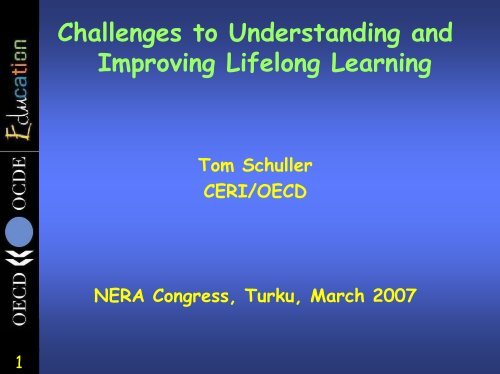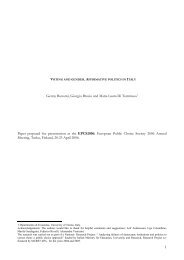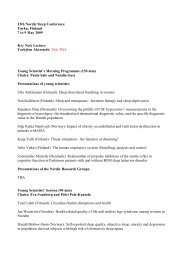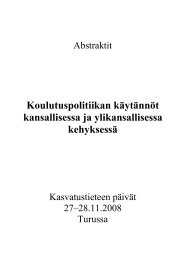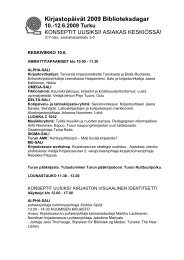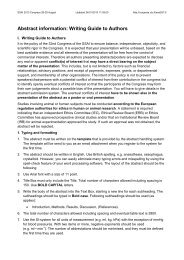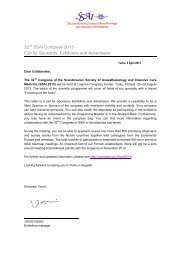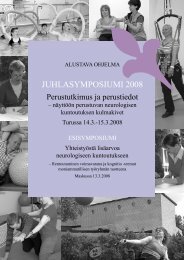Challenges to Understanding and Improving Lifelong Learning
Challenges to Understanding and Improving Lifelong Learning
Challenges to Understanding and Improving Lifelong Learning
You also want an ePaper? Increase the reach of your titles
YUMPU automatically turns print PDFs into web optimized ePapers that Google loves.
<strong>Challenges</strong> <strong>to</strong> <strong>Underst<strong>and</strong>ing</strong> <strong>and</strong><br />
<strong>Improving</strong> <strong>Lifelong</strong> <strong>Learning</strong><br />
Tom Schuller<br />
CERI/OECD<br />
NERA Congress, Turku, March 2007<br />
1
2<br />
Direc<strong>to</strong>rate<br />
for Education<br />
Centre<br />
for<br />
Educational<br />
Research<br />
<strong>and</strong> Innovation<br />
(CERI)<br />
Direc<strong>to</strong>rate for<br />
Employment<br />
Labour <strong>and</strong><br />
Social Affairs<br />
Statistics<br />
Direc<strong>to</strong>rate<br />
Direc<strong>to</strong>rate<br />
for Science<br />
Technology<br />
<strong>and</strong><br />
Industry<br />
Direc<strong>to</strong>rate<br />
For Financial<br />
Fiscal <strong>and</strong><br />
Enterprise Affairs<br />
COUNCIL<br />
SECRETARIAT<br />
COMMITTEES<br />
Environment<br />
Direc<strong>to</strong>rate<br />
Trade<br />
Direc<strong>to</strong>rate<br />
Development<br />
Co-operation<br />
Direc<strong>to</strong>rate<br />
Economics<br />
Department<br />
Direc<strong>to</strong>rate for<br />
Public Management<br />
<strong>and</strong> Terri<strong>to</strong>rial<br />
Development<br />
Direc<strong>to</strong>rate for<br />
Food Agriculture<br />
<strong>and</strong> Fisheries
3<br />
Education <strong>and</strong><br />
Training Policy<br />
Division<br />
Indica<strong>to</strong>rs <strong>and</strong><br />
Analysis<br />
Division<br />
Direc<strong>to</strong>rate<br />
for<br />
Education<br />
Centre for<br />
Education<br />
Research <strong>and</strong><br />
Innovation<br />
IMHE/PEB
4<br />
Expectations from (OECD’s) international<br />
work?<br />
<br />
Regulation?<br />
<br />
Recommendations?<br />
<br />
<br />
<br />
<br />
<br />
Evaluation?<br />
Agenda -setting?<br />
Concepts <strong>and</strong> <strong>to</strong>ols?<br />
Network-building?<br />
Statistics?
5<br />
Lisbon goals: Education Benchmarks 2010<br />
1. No more than 10% early school leavers<br />
Current projection for 2010: 14%<br />
2. Low achieving 15 year-olds in reading literacy <strong>to</strong><br />
have decreased by 20%, from 19.4 <strong>to</strong> 15.5%<br />
2003 rate: 19.8%<br />
3. Average LL participation level of 12.5% of adult<br />
working population (25-64) (currently 9.4%) Yearly<br />
progress under 0.2%, need 0.5%
<strong>Lifelong</strong> <strong>Learning</strong> as rhe<strong>to</strong>ric?<br />
Limitations of policy <strong>and</strong> evidence, due <strong>to</strong> lack of :<br />
• institutional base<br />
• professional identity<br />
• political profile.<br />
“The wider theme of lifelong learning ..has<br />
been very much neglected so far in the<br />
Bologna discussions.” (Trend IV report,<br />
p23)<br />
6
International Agenda : Data Development<br />
<strong>Challenges</strong><br />
(Tuijnman, Compare 33:4 2003)<br />
• Changing a front-loaded <strong>and</strong> input-oriented<br />
statistical system<br />
• Covering lifewide learning: non-formal <strong>and</strong><br />
informal<br />
• Integrating quantitative <strong>and</strong> qualitative<br />
• Measuring cumulative learning across the lifespan<br />
• Including a wide range of outcomes<br />
7
Hungary<br />
France<br />
Italy<br />
8<br />
70%<br />
60%<br />
50%<br />
40%<br />
30%<br />
20%<br />
10%<br />
0%<br />
Ratio of the population aged 65+<br />
<strong>to</strong> the labour force (%)<br />
2000 2020<br />
Portugal<br />
New Zeal<strong>and</strong><br />
Switzerl<strong>and</strong><br />
Korea<br />
Canada<br />
Norway<br />
Luxembourg<br />
Netherl<strong>and</strong>s<br />
Australia<br />
OECD <strong>to</strong>tal<br />
United Kingdom<br />
Slovak Republic<br />
Denmark<br />
Czech Republic<br />
Spain<br />
Austria<br />
EU15<br />
Germany<br />
Sweden<br />
Belgium<br />
Pol<strong>and</strong><br />
Finl<strong>and</strong><br />
Greece<br />
Japan<br />
United States<br />
Turkey<br />
Irel<strong>and</strong><br />
Mexico<br />
Icel<strong>and</strong>
Denmark<br />
Sweden<br />
United States<br />
Finl<strong>and</strong><br />
9<br />
50<br />
45<br />
40<br />
35<br />
30<br />
25<br />
20<br />
15<br />
10<br />
5<br />
0<br />
Participation in adult training (2003)<br />
Greece<br />
Hungary<br />
Italy<br />
Spain<br />
Portugal<br />
Pol<strong>and</strong><br />
Czech Republic<br />
Irel<strong>and</strong><br />
Germany<br />
Luxembourg<br />
Belgium<br />
France<br />
Slovak Republic<br />
Austria<br />
Canada1<br />
United Kingdom<br />
Switzerl<strong>and</strong><br />
%<br />
Source: OCDE<br />
Participation rate
10<br />
Expected hours in non-formal job-related training (2003)<br />
This chart shows the expected number of hours in non-formal job-related education <strong>and</strong> training, over a forty year period, for<br />
25-<strong>to</strong>-64 year olds.<br />
%<br />
1000<br />
All levels of education<br />
900<br />
800<br />
700<br />
600<br />
500<br />
400<br />
300<br />
200<br />
100<br />
0<br />
Denmark<br />
Switzerl<strong>and</strong><br />
France<br />
Finl<strong>and</strong><br />
Sweden<br />
Canada<br />
United States<br />
Belgium<br />
Austria<br />
Germany<br />
Portugal<br />
United Kingdom<br />
Netherl<strong>and</strong>s<br />
Hungary<br />
Spain<br />
Slovak Republic<br />
Irel<strong>and</strong><br />
Czech Republic<br />
Luxembourg<br />
Pol<strong>and</strong><br />
Greece<br />
Italy<br />
Source: OECD EAG 2006
Expected hours in non-formal job-related education <strong>and</strong> training by level of<br />
educational attainment (2003)<br />
This chart shows the expected number of hours in non-formal job-related education <strong>and</strong> training for 25-<strong>to</strong>-64-year-olds in the<br />
population by level of educational attainment<br />
1400<br />
1200 %<br />
Below upper secondary education<br />
Upper secondary <strong>and</strong> post-secondary non-tertiary education<br />
Tertiary education<br />
1000<br />
800<br />
600<br />
400<br />
200<br />
0<br />
11<br />
Italy<br />
Greece<br />
Netherl<strong>and</strong>s<br />
Irel<strong>and</strong><br />
Source: OECD EAG 2006<br />
Hungary<br />
Luxembourg<br />
United Kingdom<br />
Spain<br />
Pol<strong>and</strong><br />
Czech Republic<br />
Germany<br />
Belgium<br />
Slovak Republic<br />
United States<br />
Austria<br />
Canada<br />
Sweden<br />
Finl<strong>and</strong><br />
France<br />
Denmark<br />
Switzerl<strong>and</strong>
12<br />
14<br />
12<br />
10<br />
8<br />
6<br />
4<br />
2<br />
0<br />
Training participation rates<br />
ratio of highly qualified/poorly qualified<br />
Sweden<br />
Netherl<strong>and</strong>s<br />
Denmark<br />
United States<br />
Finl<strong>and</strong><br />
Norway<br />
Germany<br />
United Kingdom<br />
Average<br />
Korea<br />
Mexico<br />
Switzerl<strong>and</strong><br />
Austria<br />
Spain<br />
Portugal<br />
Canada<br />
Source: EULFS.
EbPR: Methodologies <strong>and</strong> epistemologies<br />
Methodological debate:<br />
Scientific ideal(s) vs best available<br />
Warfare, mutual invisibility or complementarity<br />
Capacity building:<br />
• deepening vs broadening<br />
• producers <strong>and</strong> consumers<br />
• external/rival contribu<strong>to</strong>rs<br />
• concentration?<br />
13<br />
Questions<br />
What forms of capacity are most in need of<br />
strengthening?<br />
How <strong>and</strong> by whom should this be done?
14<br />
Existence of consciousness in a locked-in ALS patient<br />
Broca’s area<br />
(word generation)<br />
Imaginary speech<br />
L (hemisphere) R<br />
Wernecke’s area<br />
(Semantic underst<strong>and</strong>ing)<br />
Speech listening<br />
ALS (Amyotrophic Lateral Sclerosis)<br />
Collaboration with Tokai Medical School<br />
L (hemisphere) R
15<br />
'Alcohol makes your brain grow’ : drinking<br />
alcohol boosts the growth of new nerve cells<br />
in the brain, research suggests.<br />
But while this might sound good in theory, the<br />
Swedish team believe these new cells could<br />
contribute <strong>to</strong> the development of alcohol<br />
dependence.<br />
Mice fed moderate quantities of alcohol grew<br />
extra brain cells, but also showed a<br />
preference for alcohol over water.
16<br />
The Politics of Measurement <strong>and</strong> Investigation<br />
Galileo <strong>and</strong> Niels Bohr<br />
Measuring the (easily) measurable<br />
The audience(s)?<br />
R<strong>and</strong>omised Control Trials (RCTs) <strong>and</strong> Mixed<br />
Methods<br />
Measures as mirrors of values
OECD/EDU Context<br />
• A stronger emphasis on outcomes<br />
• The Well-being of Nations: The Role of Human <strong>and</strong><br />
Social Capital (OECD/CERI 2001)<br />
• Broadening measurement - <strong>to</strong> include<br />
Happiness!<br />
17
18<br />
The effects of learning<br />
A<br />
Personal change<br />
Individual<br />
B<br />
Self-maintenance<br />
Transforming<br />
Sustaining<br />
C<br />
Community activism<br />
Collective/community<br />
D<br />
Social fabric
Pushpa<br />
School<br />
Social networks<br />
Communication skills<br />
Basic skills<br />
Extended family<br />
-ive<br />
Immediate family<br />
Adult<br />
education<br />
Psychological health<br />
19<br />
Purpose<br />
progression<br />
Employment<br />
Civic<br />
activity
CERI Activity 2<br />
SOL (Social Outcomes of <strong>Learning</strong>)<br />
Overall goal: develop <strong>and</strong> apply frameworks <strong>and</strong><br />
models for underst<strong>and</strong>ing the social outcomes of<br />
learning<br />
Main domains<br />
• Health (mental <strong>and</strong> physical)<br />
• Civic <strong>and</strong> social engagement<br />
Horizontal themes:<br />
• Intergenerational effects<br />
• Distribution effects<br />
20
SOL: classifying outcomes<br />
(A) Private<br />
(B) Public<br />
(1)<br />
Monetary<br />
(2) Nonmonetary<br />
Earnings, income,<br />
wealth<br />
Productivity<br />
Health status<br />
Life satisfaction<br />
Tax revenues<br />
Social transfer<br />
costs<br />
Health care costs<br />
Social cohesion<br />
Trust<br />
Well-functioning<br />
democracy<br />
Political stability<br />
21
F<br />
i<br />
g<br />
u<br />
r<br />
e<br />
2<br />
.<br />
1<br />
.<br />
Key relationships linking learning, competence <strong>and</strong><br />
capital formation<br />
Initial formal<br />
education<br />
<strong>Lifelong</strong>-lifewide learning<br />
<strong>Lifelong</strong><br />
Working life<br />
Social &<br />
civic life<br />
Home, family<br />
& leisure life<br />
Lifewide<br />
Adult<br />
learning<br />
contexts<br />
------------------<br />
•Adult education<br />
•Firm training<br />
•Informal learning<br />
Human capital<br />
Competencies<br />
Social capital<br />
Economic <strong>and</strong> social<br />
outcomes<br />
Private<br />
non-monetary<br />
outcomes<br />
Private<br />
monetary<br />
outcomes<br />
Public<br />
non-monetary<br />
outcomes<br />
Public<br />
monetary<br />
outcomes<br />
22<br />
Complex interactive <strong>and</strong> dynamic process over time
23<br />
Three Causal Mechanisms Linking Education <strong>and</strong> Outcomes<br />
Absolute Education<br />
Model<br />
Sorting Model<br />
The more education you have<br />
The more education you have vs. the<br />
average education your peers have<br />
Cumulative Model<br />
The more education your peers have
SOL: positive effect mechanisms (health):<br />
- Behaviours: awareness, utilisation of<br />
information, future orientation<br />
- Use of health services, health literacy<br />
- Psychosocial effects<br />
- Intergenerational effects, eg birthweight<br />
Collateral benefits: eg of spousal education<br />
BUT: education as genera<strong>to</strong>r of inequality ?<br />
- relative impact of additional units of education<br />
- differences between <strong>to</strong>p <strong>and</strong> bot<strong>to</strong>m of<br />
educational hierarchy<br />
24
SOL: Health<br />
Rationale: cost containment; <strong>and</strong> wellbeing<br />
Health expenditure as % of GDP: 5% in 1970 <strong>to</strong> 8.8% in<br />
2003. In all OECD countries, health expenditure<br />
rising faster than GDP.<br />
Demographics: ageing populations estimated <strong>to</strong> drive rise<br />
of 3% of GDP in health expenditure by 2050<br />
Obesity : in ten OECD countries more than 50% of adults are<br />
now defined as either being overweight or obese . The cost of<br />
health care for obese people services is 36% higher, <strong>and</strong> the<br />
cost of medications 77% higher. Can education help?<br />
25<br />
Depression:. Chevalier & Feinstein (2006) taking women without<br />
qualifications <strong>to</strong> Level 2 (just above basic) reduces risk of<br />
depression at age 42, from 26% <strong>to</strong> 22%. Estimated saving: L<br />
200m p. a. How/why does this happen?
<strong>Underst<strong>and</strong>ing</strong> Outcomes: agenda-setting or<br />
recommendations?<br />
Draft conclusions:<br />
Review public objectives of education systems<br />
Strengthen the knowledge base:<br />
causality; national divergences; indica<strong>to</strong>rs<br />
Explore implications for pedagogy, assessment <strong>and</strong><br />
qualifications<br />
Stronger ‘cost-benefit’ analyses<br />
26
27<br />
The ERI nexus<br />
Education<br />
<strong>Underst<strong>and</strong>ing</strong>/improv<br />
ing policy-practice<br />
Changing ed<br />
practice/policy<br />
Research capacity-building<br />
Policy or<br />
practice<br />
Absorptive capacity<br />
Product or<br />
process<br />
Substance or<br />
mode<br />
Innovation Research<br />
Changing research techniques<br />
<strong>Underst<strong>and</strong>ing</strong> process of innovation
What do you want from (OECD’s)<br />
international work?<br />
Regulation?<br />
Recommendations?<br />
Evaluation?<br />
Agenda -setting?<br />
Concepts <strong>and</strong> <strong>to</strong>ols?<br />
Network-building?<br />
28<br />
Statistics?
29<br />
Thank you<br />
Tom Schuller@oecd.org<br />
www.oecd.org/edu/socialoutcomes/symposium<br />
Sign up for CERI’s free electronic bulletin:<br />
www.oecd.org/edu/ceri/update


